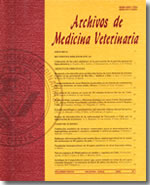Effect of reduced or increased number of pigs born alive at second farrowing on lifetime productivity of sows in southeastern Mexico
Main Article Content
Abstract
The objective of this study was to determine the effect of the change in litter size between parity one and two (DNBA) and by summed number of pigs born alive in parity one and two (SNBA) on lifetime productivity of sows in four pig farms in the tropics of Mexico. Data from 6,046 sows, with information on lifetime piglets born alive (LBA), length of productive life (LPL), number of parity at culling (NP) and piglets born alive per year (PBY), were used. Sows were categorised into 11 DNBA groups: ≤-5,-4, -3, -2, -1, 0, +1, +2, +3, +4 and ≥ +5 piglets, and 5 SNBA group: ≤ 17, 18 to 20, 21 to 22, 23 to 25 and ≥ 26 piglets. A positive linear trend was observed for LBA, LPL and PBY for sows that decreased in ≤ 5 piglets to sows that increased in ≥ 5 piglets. Sows with greater SNBA stay longer in the herd and produced more piglets during their productive lifetime. Sows that increased litter size at second parity and those that produce more piglets in their two first parities were more productive.

